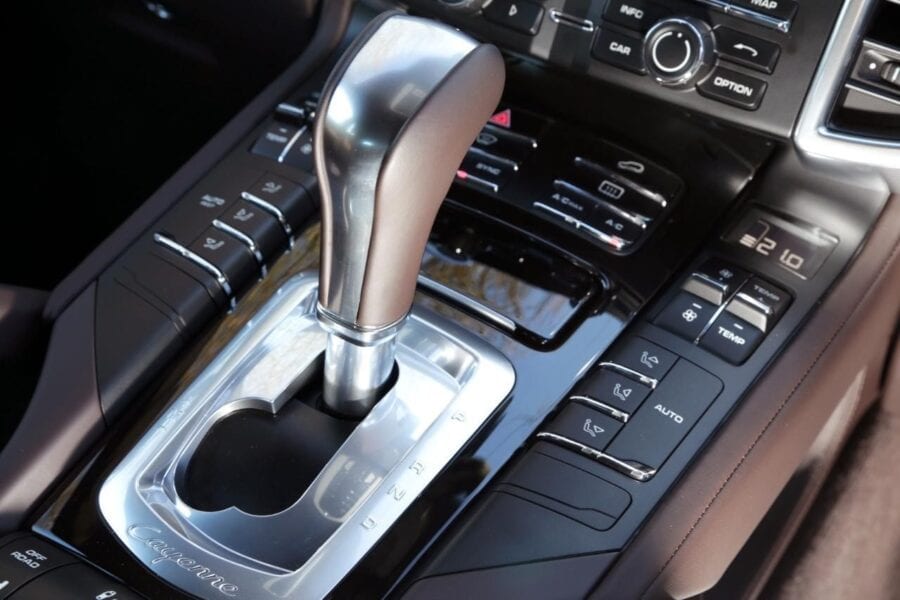
Gearbox Types
Content
The transmission is an important component of the device of any vehicle, thanks to which you can easily:
- change engine torque;
- control the speed and direction of the car;
- safely disconnect the engine from the wheels.
Gearbox Types
The truth is that there are a lot of types of gearboxes with which cars are equipped, and within the framework of one article it is difficult to consider in detail the features of each of them. Consider a few basic types of gearboxes that most modern cars are equipped with.
Variable speed drive
This type of gearbox is also called a continuously variable transmission or CVT. The CVT is an automatic transmission option, and what distinguishes it from all other types is a smooth set of speeds.
CVT advantages:
- efficient use of engine power due to the maximum adjustment of the load of the chassis with a crankshaft speed;
- optimal fuel efficiency is achieved;
- continuous transmission of torque;
- excellent level of comfort while driving.
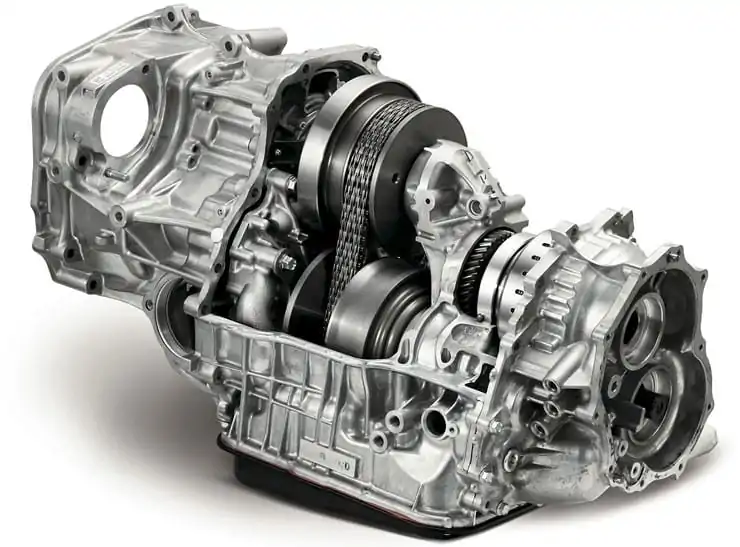
The disadvantages of this type of gearbox are:
- restrictions on the amount of transmitted torque;
- high technological complexity of the design;
- its more expensive service.
At present, CVT gearboxes are used mainly in cars of the Nissan, Subaru, Honda, Fiat, Opel, Chrysler, Mini, Mitsubishi brands. Recently, there has been a tendency to expand the use of variator gearboxes.
How does a CVT gearbox work?
Let's pay a little more attention to the operation of the variators, because, unlike other types of gearboxes that transmit torque using gears, in the variators this torque is transmitted through a steel, flexible V-belt or chain.
The V-belt variator consists of one or, in very rare cases, two drive belts. The transmission includes two more washers and two cone-shaped discs facing each other.
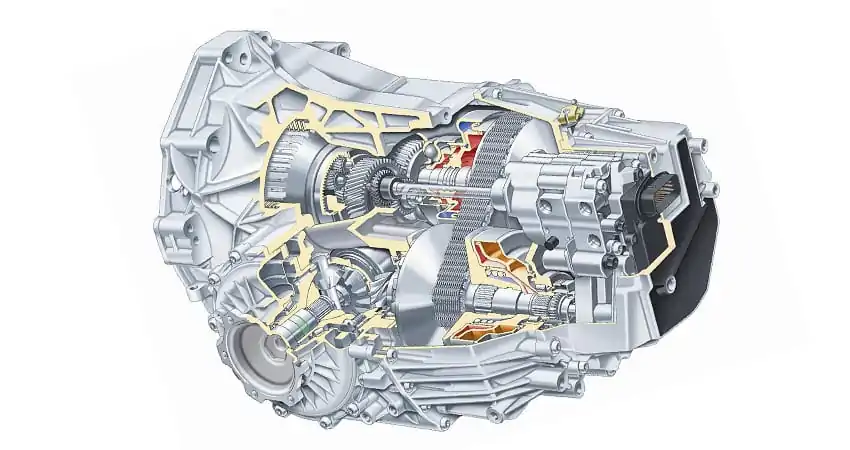
Hydraulic pressure, centrifugal force and spring force are used to bring the cones together and separate them. The tapered discs have a 20-degree tilt, which helps the belt move along the surface of the washer with the lowest possible resistance.
The mechanism of operation of the variator is based on a coordinated change in the diameter of the belt depending on the operating conditions of the engine. The diameter of the washer is changed using a special drive. When starting the car, the drive pulley of the variator has the smallest diameter (conical disks are located as far as possible from each other).
As speed increases, the belt moves to a larger drive roller diameter. Thus, the variator gearbox can maintain the optimal engine speed, while at the same time providing maximum power and providing very good dynamics of the car.
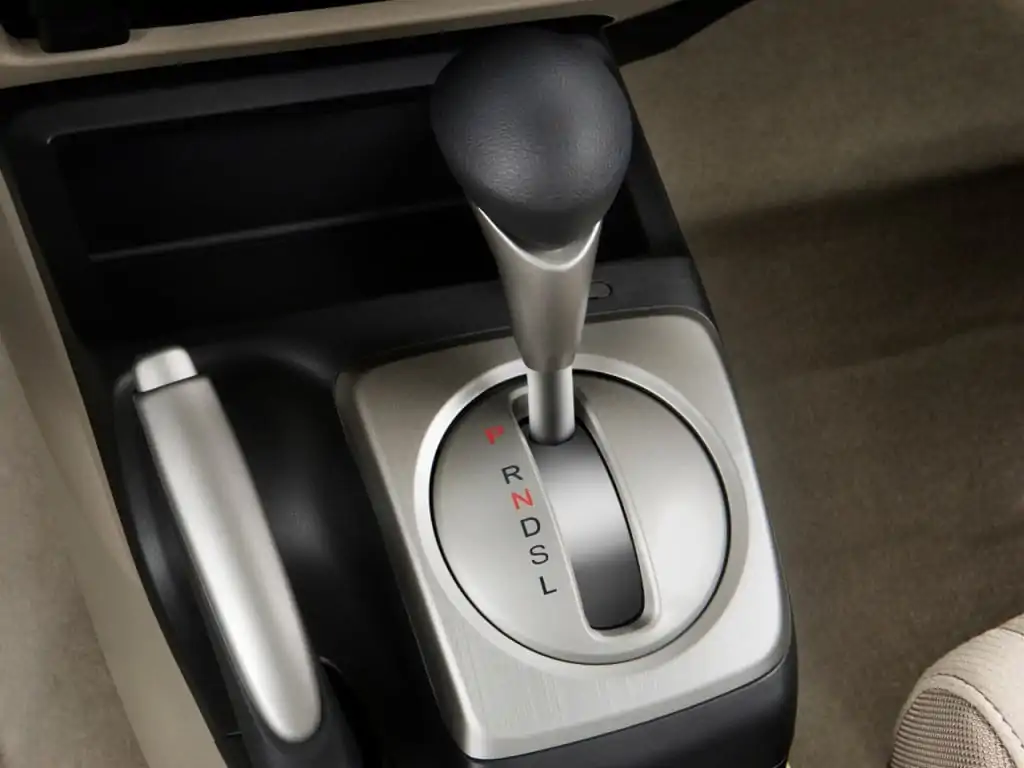
In other words, a V-shaped CVT achieves maximum efficiency with the lowest possible power loss during rotation. The CVT gearboxes use an electronic control system, due to which the synchronous change in the diameter of the washers is carried out in accordance with the operating modes of the engine.
CVT is controlled by a gear selector, and control modes are similar to automatic transmission, the difference is that the variator has the function of choosing a fixed gear. This function basically solves the psychological problem of drivers who find it difficult to get used to the constant engine speed while driving. This function has different names depending on the manufacturer (Sportronic for Mitsubishi, Autostick for Chrysler, etc.)
Sequential (sequential) gearbox
Until recently, sequential or sequential gearboxes were used mainly on motorcycles and racing cars, but in recent years they have been installed on expensive cars.
The difference between traditional and sequential gearboxes is mainly that you can select any gear in standard gearboxes, with sequential gearboxes you can select and shift only adjacent gears (above or below the one used previously).
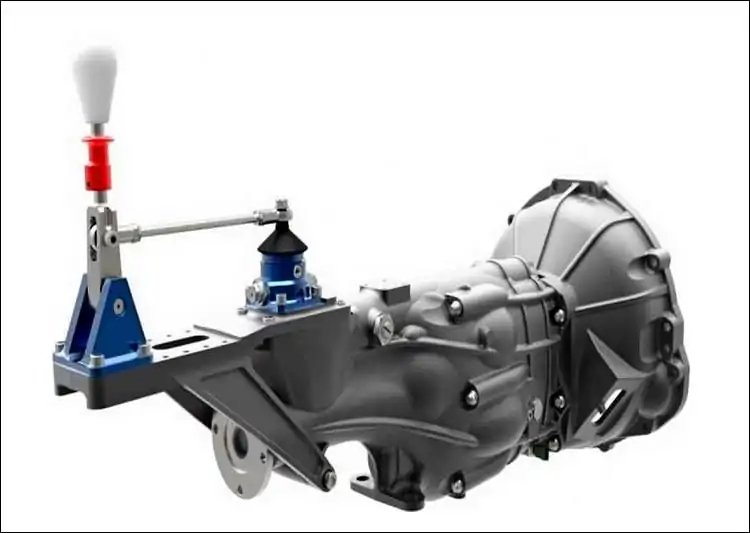
Although similar in design and work with manual gearboxesThe sequential ones do not have a clutch pedal. In other words, the clutch is controlled not by the driver, but by the electronic unit, which receives the signal from the sensors. They activate the necessary gear with the appropriate pressure on the accelerator pedal.
Pros:
- provide high speed and ease of shifting between gears - thanks to the electronic control unit, gear shifting time is minimized (up to 150 milliseconds);
- when shifting gears, speed is not lost;
- economical fuel consumption;
- the ability to select manual or automatic gear shifting (the so-called "sports mode").
Cons:
- instability under high loads and faster wear - the elements of this type of gearboxes are very delicate and sensitive, which leads to faster wear;
- if you do not know how to handle the box correctly, the probability of its loading is very high, and, therefore, the likelihood of problems is also high;
- gears can be a little more awkward and not very smooth when driving in urban environments and at low speeds;
- high maintenance costs - Sequential gearboxes are machines with a complex design, which inevitably increases their maintenance costs.
Automatic transmission
Most motorists are familiar with the classic automatic transmission. Briefly consider what it is. When switching gears in a manual gearbox, you have to depress the clutch pedals and move the lever to the appropriate position. In automatic gearboxes you do not have to do almost anything, because they are controlled completely automatically (via the electronic control unit).
Pros:
- smooth and fully automatic gear shifting, providing incredible driving comfort;
- the clutch does not need periodic replacement;
- the car can easily adapt to your driving mode;
- ease of operation, which allows even inexperienced drivers to quickly learn how to manage automatic transmission;
- provides faster response to gear changes.
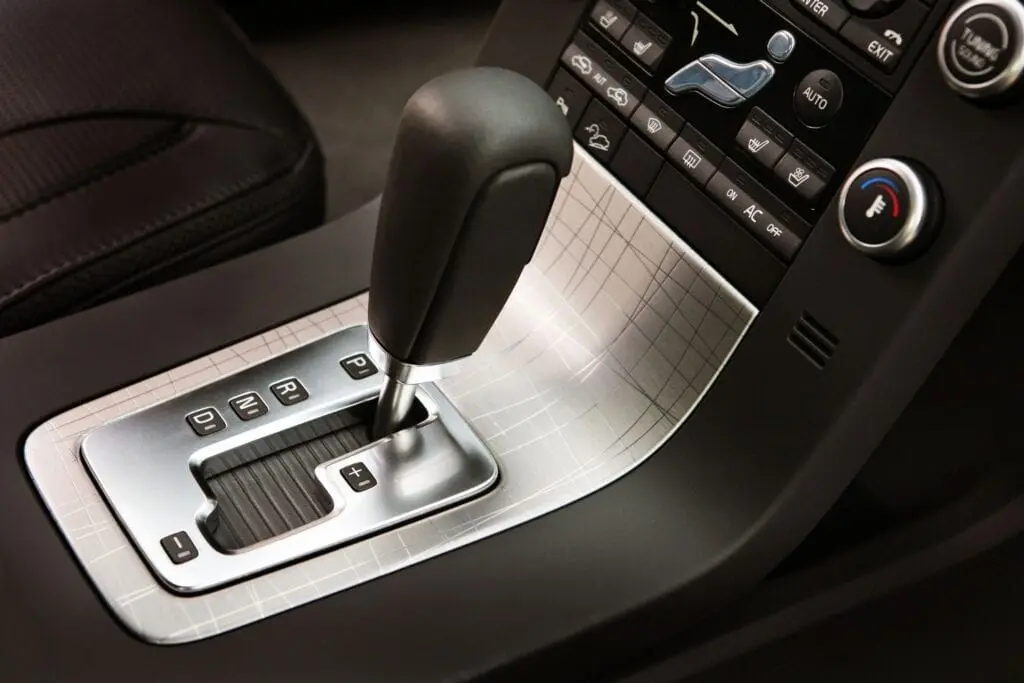
Cons:
- complex device;
- higher price compared to a manual gearbox;
- higher maintenance costs;
- higher fuel consumption and slightly lower efficiency compared to a manual gearbox.
DSG gearbox
The DSG gearbox, also called the dual-clutch gearbox, is a variant of the automatic gearbox and belongs to those types of gearboxes that are of increasing interest.
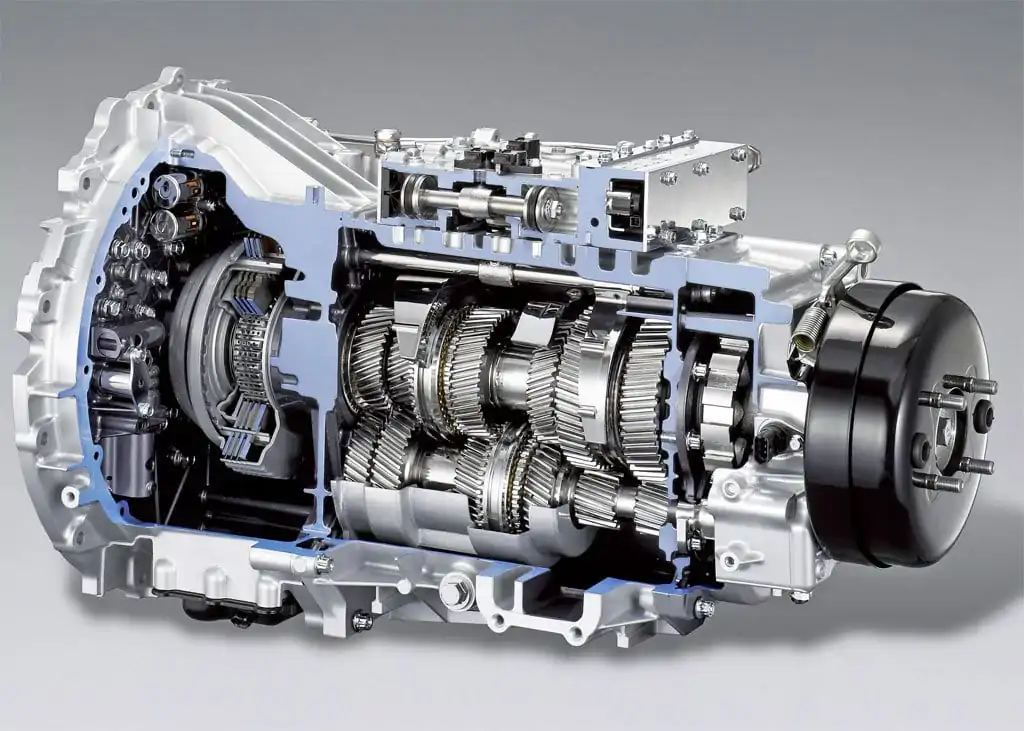
What is the peculiarity of transmissions of this type? The system uses two clutches for an extremely fast gear shift, which makes discreet changes when changing gears. In addition, this type of transmission is usually accompanied by an additional lever on the steering wheel of the car, which allows you to shift gears manually if the driver decides (shift paddles).
How does DSG work?
As already mentioned, this type of gearbox has two clutches. When one clutch is engaged in the current gear, the other clutch prepares the next gear, which significantly reduces the shift time. Dual clutch vehicles do not have a clutch pedal, as it activates and deactivates automatically.
Most DSG gears use an automatic selector to change driving modes. In Drive or Sport mode, the dual-clutch transmission operates like a standard automatic transmission. In “D” mode, the transmission upshifts earlier to minimize engine noise and maximize fuel economy, while in “S” mode, downshifts are held a little longer so the engine can maintain its power.
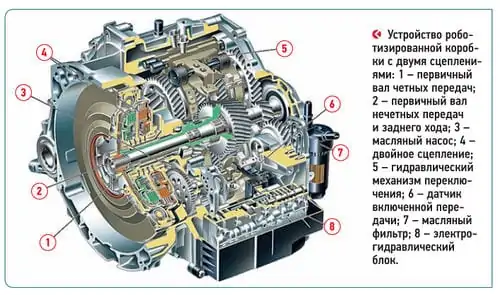
The DSG is available in two versions - DSG 6 and DSG 7. The first version is a six-speed gearbox. It was released by Volkswagen in 2003, and its peculiarity is that the dual clutch is wet (that is, its gears are partially immersed in a container of oil).
The main disadvantage of the DSG 6 is the significant loss of power due to the fact that it runs in oil. That's why in 2008 Volkswagen introduced its new version, the DSG 7 (seven-speed dual-clutch transmission), which uses a dry clutch.
Advice! If you have a choice between two options (DSG 6 and DSG 7), choose the first one - they are more durable
Pros and cons of DSG:
The most important advantage of a dual-clutch gearbox is that it has the characteristics of a mechanical gearbox and combines them with the comfort and convenience of an automatic gearbox.
Its disadvantage is the restriction of gears. Since it has a fixed number of gears, the transmission does not always allow you to maintain the best engine speed. In addition, DSGs cannot provide minimum fuel consumption. To the disadvantages, we can add an even higher price and expensive service.
Tiptronic
Tiptronic is a box that works on a mechanical principle, the difference is that there is no clutch pedal. Instead, the piloted transmission has computer-controlled mechanisms that disengage and engage the clutch when shifts need to be made.
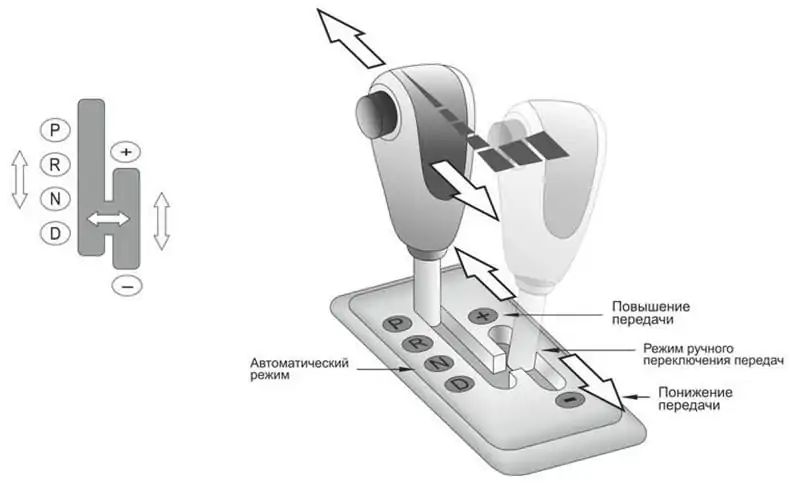
This allows the computer to control gear changes without losing the feel of driving a car with a manual gearbox. Among the advantages of this type of gearbox:
- smooth speed switching;
- affordable price.
Among the shortcomings, it can be noted that you need some time to get used to working with tiptronic.
Questions and answers:
How many gearboxes are there? There are two types of gearboxes in total: automatic or manual. As for the mechanics, it may differ in some details. Automatic boxes can be fundamentally different.
What types of automatic transmissions are there? Automatic transmissions include: an automatic (with a torque converter - a classic automatic), a variator (continuously variable transmission) and a robot (an automatic analogue of mechanics).
What's the best gearbox? It depends on the performance desired by the driver. For complete control over the driving process - mechanics. For lovers of comfort - one of the automatic options. But sports driving is most effective on mechanics.